Today’s GDP numbers were about what I was expecting. Although economic activity continued its sharp decline, if we continue to follow the script, things should improve.
The Bureau of Economic Analysis reported today that U.S. real GDP fell at a 6.1% annual rate in the first quarter of 2009. That’s enough to push our Econbrowser Recession Indicator Index up to 99.5%, its highest value since 1980:Q2. This index uses the latest GDP numbers to form a retrospective impression of the economy’s status as of one quarter earlier (2008:Q4). We will declare the recession to be over when the index falls back below 33%.
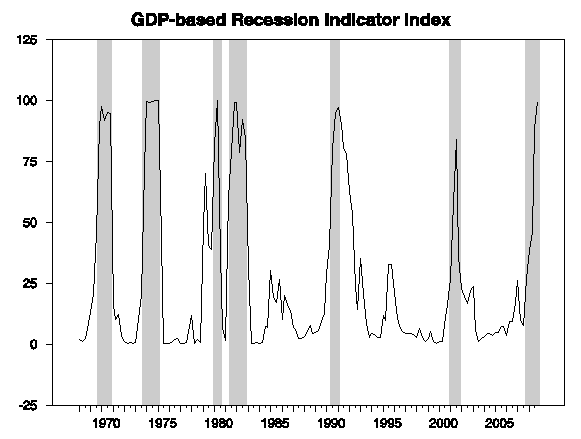
|
Leading the retreat in real GDP was a 9.5% drop (quarterly rate) in nonresidential fixed investment. This was enough all by itself to subtract 4.7% from the annual GDP growth rate. There was a comparable drop in residential fixed investment, which subtracted another 1.4% from the implied annual GDP growth rate. The collapse in nonresidential fixed investment was what we expected, given the usual cyclical pattern of plunging business fixed investment in the later stages of an economic downturn. The drop in housing surprised me somewhat. If new home construction does no better than simply hold steady at its current abysmally low rate, the sector will stop making negative contributions to the growth rate.
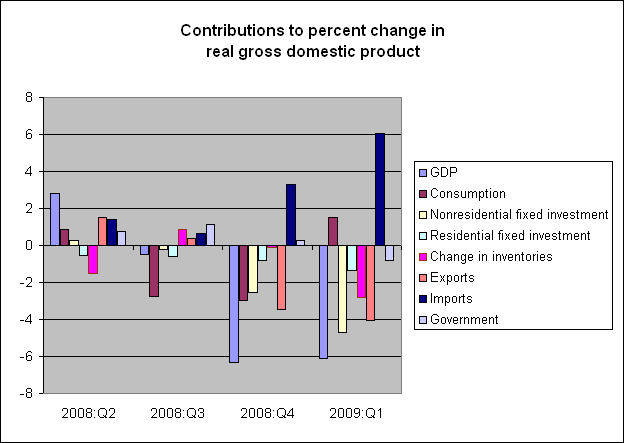
Because imports are subtracted from GDP, falling imports made a big positive contribution to GDP growth, much of which was taken away by plunging exports. But it would be quite wrong-headed to summarize these twin developments solely in terms of their net implications for U.S. GDP. The simultaneous drop in imports and exports signals an accelerating collapse in world trade, which I see as the single most troubling detail of today’s report.
On the bright side, inventory liquidation subtracted 2.8% from the quarter’s annual real GDP growth rate, meaning that real final sales were substantially better than GDP. Most importantly, consumption rebounded from the depressed levels of 2008:Q4.
That last development is particularly key, since the historical pattern is for consumption to begin the recovery in the later phases of the recession, even as nonresidential fixed investment is headed down.
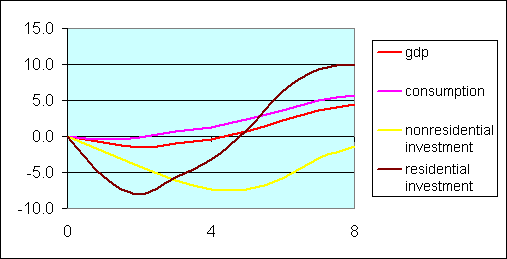
|
If you want to see that pattern of recession and recovery blown up on a bigger scale, you can look just at the downturn of 1981-82:
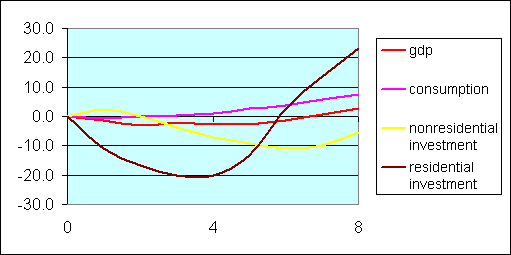
|
Here’s how these series have behaved so far this time:
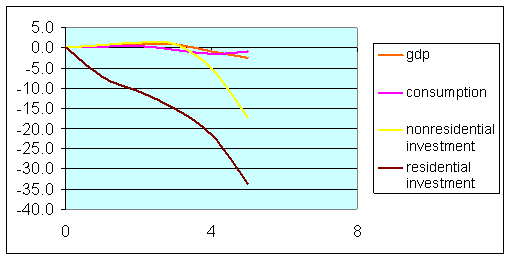
|
If this is all unfolding according to historical pattern, that’s a source of comfort, because we saw how those earlier recessions ended. If consumption continues to grow, and if residential fixed investment has finally bottomed, then the 2009:Q2 decline in GDP should be milder than Q1, and positive growth by the end of the year could be in store.
Though I grant it takes a little imagination to see that in the graph above.
Technorati Tags: GDP,
recession probability,
recession indicator index,
macroeconomics,
economics
JDH,
In the econ 101 flow of funds diagram, consumers make there money (rent) from contributing labor or capital to business. If business is scaling back on capex and investment in inventory, doesn’t that mean that consumers will eventually earn less? So why are they still spending? Are they more confident than the business community?
For my money, 1974 is probably the right recession for comparison, although I personally expect a sharper rebound now.
Do we really know a lot about recessions? It seems to me that there are at least three types: inflation-led (1979-1983); investment-led (Japan?), and debt-led (this recession, 1929?, various developing country recessions).
My recollection from 79-83 was a feeling of grinding recession, as Volcker simply crushed inflation out of the system. The current recession, by contrast, feels like a panic.
In any event, do we not have eager doctoral students in need of a thesis? There seem to be so many out poorly understood topics out there.
“Though I grant it takes a little imagination to see that in the graph above.”
Especially since the second derivatives of the investment series appear to be zero or negative (cf the 1980 recession at the time consumption started to rebound)
JDH wrote:
Because imports are subtracted from GDP, falling imports made a big positive contribution to GDP growth, much of which was taken away by plunging exports. But it would be quite wrong-headed to summarize these twin developments solely in terms of their net implications for U.S. GDP. The simultaneous drop in imports and exports signals an accelerating collapse in world trade, which I see as the single most troubling detail of today’s report.
Thanks Professor. This is what I was looking for in an earlier thread by Menzie. This is right on target and I totally agree.
In all these analysis, do You take the other world dynamics into account at all, or it does not matter for/are subordinated in some way to USA business cycles?
If not that unknown other world, from what is clear from Your site, the USA stock market will shoot up in July latest when Q2 GDP results will become available.
A large portion of the -6.1% was due to inventory liquidation. If you look at final sales you can see improvement in the economy over Q4 even though their growth rates were similar.
Final Sales
2008 Q4: -6.2%
2009 Q1: -3.4%
Duly noted by JDH’s 2nd graph Steve, but overshadowed by the turnaround in consumption, yes? ~4.5% (confirmed by Table 2)
And it seems to be due to….durable goods. Of those durable goods (Table 2) it is…motor vehicles and parts.
And we know it isn’t new car sales…so it must be parts.
Dang I feel like Sherlock today…other than that, I am quite bewildered by the growing trade imports…didn’t Menzie just post that trade was cliff diving?
Professor Hamilton, are we sure this recession is like the others? Early 1980s’ crisis isn’t something we should look at too much, I think.
We now have:
-A banking crisis
-Collapsing world trade (almost 70% of the world is currently in recession)
-Ineffective monetary policy (so far, ingenious measures translated directly into skyrocketing bank reserves)
As “minor” factors, we have
-Collapsed confidence in the financial system
-Oil price that is waiting just the smallest attempt at recovery to jump over 80$ again
-The second (or first?) biggest economy (EU) that simply does not care about economic policy at all and is proud of his straitjacket
I’m not saying that it’ll be Armageddon (a 52% annualized drop in investment is pretty scary, though), i was just wondering: if this is the situation, are we sure the recovery will follow the historical pattern? Did we ever had these complications all together anytime in the past?
The plunge in imports may feed to a future plunge in exports that greatly exceeds the drop we have seen so far (from feedback effects as foreign markets respond to the decline in U.S. demand). In this case, if imports begin to climb – either as a result of recovering consumption (which I seriously doubt) or an increase in foreign exchange intervention (which I fully expect) – then we may see a frightful reversal in the contribution of the trade balance to U.S. GDP. In this regard, the Fed’s current policies appear to be short sighted.
Since the inventory reduction process is now complete, the recession moves from ‘severe’ to ‘mild’ again, as it was from Dec’07 to Sept’08. This is still not a recovery or even a trough, mind you.
The inventory correction is a one-time thing.
Professor,
Guess you are right.
Indeed, all the folks around me are getting tired of telling bad news, hearing bad news – therefore the rebound might come sooner than later. Hm, yes.
Why should a better-than-expected decline in consumption be good for the economy? I note that personal savings rate rose to 3.2% in 4Q2008 and could have reached 4% in the last quarter. So consumers are not only saving but possible also having more savings from lower interest rates to support spending.
My concern is with the steep decline in non-residential investment and exports, which indicates that the productive capacity of the economy is deteriorating.
Carlo’s aggravating factors form an excellent list to which may be added the household’s balance sheet rectification and its associated paradox of thrift and long-term recovery implications a la Japan.
Our trade with China continue to plunge yet the Chinese markets are in a rally greater than the US. For the first two months of 2009 imports from China are down $6,673.8 or 13.3% from 2008. The month of February alone was down 5,254.1 or 21.8%.
Trade with China is critical for recovery. The Chinese were buying US paper with the money they were receiving from US imports of Chinese goods. With the plunge in trade China will not return to financing Fannie and Freddie and the US economy will continue to decline.
But the rise in the Chinese stock market in spite of the decline in US trade means that the Chinese are coming out of the recession without relying on the US.
Many of us expected this but it appears that the statistics are supporting our position. China is making economic moves in the right direction, away from mercantilism, while the US is embracing it with both arms. China will be THE market of the future simply because the US is throwing it away.
The first quarter consumer spending boost is thanks to everyone receiving their IRS tax refunds and spending them. We’ll see a much different attitude in consumer spending next quarter.
Real personal consumption expenditures were up 0.9% in Jan. and 0.1% in Feb., and down 0.2% in March.
http://www.bea.gov/newsreleases/national/pi/pinewsrelease.htm
This is what I would expect — falling consumption, now — given the terrible debt load on households and the falling employment levels.
And, with Ben’s quantitative easing failing to bring interest rates down, and with interest rates now marching up, the fall in real PCEs will only accelerate.
This in The Atlantic:
http://www.theatlantic.com/doc/200905/imf-advice
We are in real, deep trouble as a country and a world!
I know that many of you believe in the theory of slack in the system (as Menzie puts it). This video will give you a good view of this slack and why the whole idea of stimulating unsustainable demand leads to malinvestment and wealth destruction. You will see the destruction right before your eyes. Listen as the commentator describes as he makes a powerful economic point without knowing it.
http://www.youtube.com/watch?v=ZsgOaCZ2Lag&eurl=http%3A%2F%2Fblog%2Emises%2Eorg%2Fblog%2F&feature=player_embedded